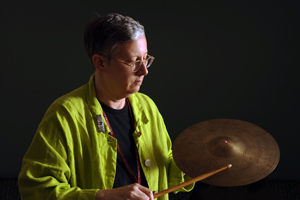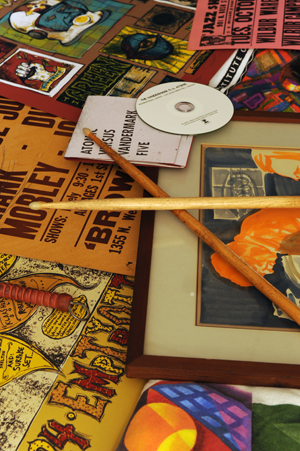Behind the music
Love of music, and the musicians, drives Deborah Gillaspie’s commitment to the Chicago Jazz Archive.
By Jake Grubman, ’11
Photography by Dan Dry

Mixing professional expertise and personal passion, Gillaspie has built the jazz collection.
Jazz curator Deborah Gillaspie’s (AM’88) work has never been confined to her office on the third floor of Regenstein Library. She has listened to the cassette tapes covering her desk and read the books lining her shelves, but Gillaspie’s preferred method for connecting the Chicago Jazz Archive with the local community is simple: she goes out and meets the musicians.
Attending local concerts as a fan and drummer since 1990—although she no longer plays—Gillaspie befriended some of the area’s best musicians and greatest aficionados, and later she preserved their collections at the library. Pianist Willie Pickens and saxophonist Jimmy Ellis live down the block in Hyde Park. The late saxophonist Franz Jackson also was an old friend.
Gillaspie recalls Jackson’s first donation to the library—a blue suitcase jammed with papers that he handed to her one night at Joe’s Bebop Café on the North Side. Remembering his music, she lights up. “He played until three months before he died—he had pneumonia—but man, all you had to do was hand him the horn, and he just kicked butt.”
Since 1997 Gillaspie’s passion for jazz and close relationships with musicians has spurred the Chicago Jazz Archive’s rapid development. Now she scrolls through the library’s website, rattling off the tools the Reg has added to make jazz research more accessible. As recently as four years ago, Gillaspie herself was practically the only tool the library had to connect the archive with researchers and fans, answering more than 500 reference questions and meeting nearly 70 visitors per year, by her estimation.

The memorabilia has emotional resonance.
As she continued to acquire material, the archive crossed the line between paper and audio—an unwritten library rule kept music on the third floor and paper in Special Collections. After Gillaspie met with Special Collections archivist Alice Schreyer, library director Judith Nadler, and Sem Sutter, AM’73, PhD’82, AM’85, assistant director for collections at the library, things started to change. “The four of us just looked at each other, and we said, ‘Why are we trying to run two separate archival operations?’”
A year later the Andrew W. Mellon Found-ation selected the library’s Uncovering New Chicago Archives Project for a $600,000 grant, funds the Reg used in part to move the jazz audio holdings to Special Collections. In processing and creating online finding aids, Special Collections opened a new venue for interacting with the Chicago Jazz Archive. Now researchers can visit the library’s website to search for particular musicians or venues—tools that Gillaspie continues to develop.
While Gillaspie has been a driving force for the jazz archive website, she also maintains a presence in the jazz community. “You go out, you listen, you talk intelligently about the music, and then [the musician’s] spouse calls and they’ve passed away, and you do what you can to help,” she says. “You go to a lot of funerals; that’s the downside.”
She tries not to push people to contribute to the archive. “I don’t go out beating the bushes. I just remind them that none of us are getting any younger, and they’re free to call me.” One late musician’s wife called as she herself was dying, having finally decided to donate her husband’s career materials.
Soon after, the woman died of cancer. “No gift comes without a price,” Gillaspie says. “It’s hard to see somebody you love die that way. These aren’t just—they’re my friends. You can’t do this job and be remote from it.”Return to top
